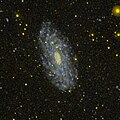|
NGC 2090
NGC 2090 is a spiral galaxy located in the constellation Columba. Its velocity with respect to the cosmic microwave background is 994 ± 5 km/s, which corresponds to a Hubble distance of 47.8 ± 3.4 Mly (14.65 ± 1.03 Mpc).[2] However, 51 non-redshift measurements give a distance of 42.46 ± 0.64 Mly (13.018 ± 0.197 Mpc).[5] It was discovered on 29 October 1826 by Scottish astronomer James Dunlop.[6] NGC 2090 was studied to refine the Hubble constant to an accuracy within ±10%.[1] See alsoGallery
References
External linksWikimedia Commons has media related to NGC 2090.
|
||||||||||||||||||||||||||||||||||





